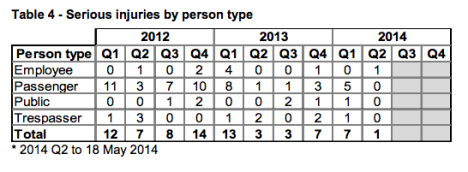Has Dumb Ways to Die been effective?
 While Dumb Ways to Die has won more creative awards than almost any other it has not been able to replicate that success in the coveted effectiveness categories. Miranda Ward investigates whether the much-vaunted campaign was ultimately a failure.
While Dumb Ways to Die has won more creative awards than almost any other it has not been able to replicate that success in the coveted effectiveness categories. Miranda Ward investigates whether the much-vaunted campaign was ultimately a failure.
Recently AdAge named Metro Trains’ Dumb Ways to Die campaign as the 12th best campaign of the 21st century, an accolade largely based on the its creative prowess after it stormed the Cannes Lions advertising festival in 2013 to become the most awarded campaign in the history of the awards.
However, questions have been raised over how effective the campaign was in its goal of keeping Melburnians safer around trains, after it failed to win metal in the Creative Effectiveness category at Cannes last year, and picking up just a silver and two bronzes at the Australian Effies in 2013.
The campaign, created by McCann Melbourne, launched in the third quarter of 2012, and to date has more than 97m views on its official YouTube video, as well as spawning dozens of cover versions and unofficial uploads.
It had four prime objectives, according to a case study submitted to The Communications Council for the Australian Effie Awards in 2013:
- Increase public awareness and engagement with rail safety (there was not sufficient data to provide us with a benchmark
prior to this campaign. This campaign was designed to set measurable objectives in terms of awareness & engagement)- Generate PR, buzz and sharing around our message about rail safety. Although an exact Key Performance Indicator (kpi) could not be determined there was an expectation that the campaign would generate earned media on and offline.
- Invite a commitment to be safe (we a drew a line in the sand and looked to get 10,000 local pledges on our website) in a 12-month period
- See a reduction of near misses and accidents at level crossings and station platforms over 12 months by 10 per cent.
 A case study submitted for the Creative Effectiveness Lions also lists similar campaign aims.
A case study submitted for the Creative Effectiveness Lions also lists similar campaign aims.
It was the campaign’s objectives that one effectiveness award juror told Mumbrella “didn’t match up with the results at the end”.
They said: “They [McCann Melbourne] did a really good job trying to validate their results. The discussion in the [jury] room was the actual results versus claimed numbers in different areas was quite different.
“They tried to justify it by taking a three month window when a lot of the activity was actually in market that they tried to sell through.”
The jury member said the numbers the case study put forward, including “extraordinary views on Facebook”, “didn’t really correlate with the period they were measuring against or have anything significant against people around that vicinity”.
“At the end of the day it’s a local area marketing campaign so it should have had local area marketing measures against it,” the jury member added.
In February 2013, Metro Trains general manager of corporate relations and business development Leah Waymark said the three-minute cartoon had prompted a sharp reduction in “risky or dumb behaviour” such as walking or driving around boomgates at level crossings.
Waymark said the campaign had seen a 20 per cent drop in “dumb behaviour” on train platforms in the Melbourne area in the two months directly after the launch of the safety video, with incidences of near misses at stations also down 20 per cent against the annual average.
But speaking to Mumbrella Waymark was more cautious about attributing any decreases in near misses or injuries directly to the campaign.
“When it comes to near misses, the reporting has increased quite significantly. You can’t use that data really because we’ve implemented new reporting hotlines and incentives to encourage drivers and station staff to report near misses, so we’re collecting a lot more data then we have ever before,” she said.
“We’re taking lots of steps [to reduce injuries and deaths], Dumb Ways to Die is only one component of it. Even with these reductions I wouldn’t just put it down to Dumb Ways to Die, it’s really a collection of a range of things we’re doing and safety is a big focus for us.”
However, in the case study submitted to The Communications Council’s Australian Effie Awards last year, McCann was confident a correlation between an improvement in accident figures and the campaign existed.
The case study, written by McCann Melbourne managing director Adrian Mills and strategic planner Danish Chan, said: “Typically attributing the sole success of a reduction of accidents and deaths to an advertising campaign is dubious. Commuter numbers, weather, ongoing safety activities, and high profile incidents all contribute to changes in public behaviour around trains.
“However due to the strong correlation between the campaign’s launch in November, the level of attention it gained in both traditional and social media and the minimal changes in Metro’s safety procedures, we believe that Dumb Ways to Die has had a considerable impact on these safety results.”
On the campaign’s role in reducing near misses and accidents around trains by 10 per cent, the case study said: “To accurately compare year-on-year statistics we look at the number of near misses in and around stations per million boardings and for level crossings we look at the number of incidents per million kilometres travelled.
“The biggest improvement was in the number of collisions or near misses with vehicles and pedestrians at level crossings.
“Although it’s too early to be confident of a sustainable reduction in near misses, the early signs are encouraging,” the case study continued.
“For the November to January period in 2011/12 there were 13.29 near misses per million kilometres while for the same period in 2012/13 there were 9.17 per million kilometres.”
On the campaign’s results Waymark told Mumbrella: “Passenger serious injuries have gone from 31 in 2012 to 13 in 2013 and 5 for the first half of 2014.
“The difficulty with this is it is a behaviour change campaign and how do you measure if you have in fact averted a death?
“In terms of injuries, that is the consequence of someone taking a risk or had an accident, those numbers have definitely gone down quite significantly over that period.”
According to numbers on the Transport Safety Victoria website, which include employees, passengers, public and trespassers, in the first quarter of 2012 three people were killed around trains while 12 were seriously injured.
Quarter two, directly before the campaign’s launch, saw four people killed and seven seriously injured while in quarter four, directly after the launch of the campaign, two people died and 14 were seriously injured.
In 2013 those numbers halved with a five people killed across the year, while 26 were seriously injured. And in the first half of 2014, through to May 18, four people were killed and eight were seriously injured.
Transport Safety Victoria has not yet released the numbers for the last half of the year.
McCann’s Mills told Mumbrella one of the long term impacts of the campaign will be the “cohort of young Victorians who have played a rail safety message on their phones by the time they start taking public transport themselves”, which ties in to the campaign’s third objective to get 10,000 Melburnians to pledge to be safe around trains.

 To date the campaign has had around 90m pledges to be safe around trains, Mills said.
To date the campaign has had around 90m pledges to be safe around trains, Mills said.
“This is from people hitting buttons and taking photos and pledging to be safe around trains.”
He said the campaign had 43 per cent awareness amongst 16-64 year olds across Australia, according to research.
“Then we have 70 per cent of kids in Australia who are aware of the campaign and 67 per cent of those have been actively involved in engaging with the campaign.
“If you talk to anyone under 10 about Dumb Ways to Die they’ll talk to you about how much they love it and tell you exactly what it’s about. We turned Metro Trains into Disney,” Mills quipped.
“You’ll hopefully see a long term effect there.”
While the engagement with children is quite impressive it does not prove the campaign has been effective as their target market, according to the case study, was 18-29 year olds, of which only 46 per cent reported having seen the campaign.
As the the jury member told Mumbrella the problem with the campaign’s case study was it “never set out to own the conversation” around safety and trains and rather it was just a “contagious idea” which took off in unexpected ways, including capturing the imagination of younger children.
For the jury member this is why the campaign is not as effective as it could be, because it can be argued some of the results are accidental or bonuses rather than intentionally planned for.
“Clearly it was a brilliant, contagious idea that went off and went far-beyond anything they ever thought it was going to,” the jury member said.
On the target audience for the campaign Waymark said: “This is a behaviour change campaign and it is particularly aimed at people who take risks. It targets young people, many of whom are recent customers or those likely to be customers in the coming years, and we then extend the campaign into our school education program.
“Within that we particularly focus on grade 6 students. We know that most times when parents are going to first allow their children to start using public transport independently are when they hit high school age. We use Dumb Ways to Die messages as the core of our school education program. We have a team of people who go into primary schools around Melbourne.”
The case study submitted to The Communications Council stressed the popularity of the song, the focal point of the campaign.
“During the first few months of the launch of Dumb Ways to Die, the song garnered astronomical attention and engagement. Dumb Ways to Die was so engaging it charted on iTunes in 28 countries,” it read.
Since its launch the campaign has been continually active, branching into merchandise and video games.
“The greatest engagement has definitely been through the game,” said Mills.
“The first game, which is still doing quite well, it went to number one in 31 countries, and has 97 million downloads and has been played 1.6b times.
“That’s kind of crazy when you think about engagement for a rail safety campaign.”
Metro Trains followed up the first game with a second one, launched in November last year.
“The latest version of the game we’ve launched went to number one in 83 countries on the iPad and over 50 countries on the iPhone,” said Mills.
“In a couple of weeks it’s had 2m downloads.”
Along with the launch of the games, Metro Trains and McCann Melbourne created a number of pieces of content to mark occasions throughout the year, such as Valentine’s Day and April Fool’s Day, in an effort to extend the campaign.
“Last year we put out 11 different Dumb Ways to Die pieces of film content which collectively add up to 25m views,” said Mills.
“There is still massive appetite.
“We released a Christmas single and it went to number six in a couple of countries. In Australia it was the sixth biggest Christmas single.”
Dumb Ways to Die is, creatively, a winning idea, as is evidenced by an unprecedented five Grand Prix’s at Cannes, a Black Pencil at D&AD and dozens of other local and international awards.
But while awards and tens of millions of YouTube views are a bonus for marketers and agencies, the point of the campaign was to raise awareness of train safety amongst 18-29 year olds in the Melbourne metro region. Has it done so?
According to Metro Trains’ Waymark while it may well be a contributing factor the reduction in near-misses cannot be attributed solely to the campaign, suggesting we can put a cross next to that objective
And while it was wildly popular with younger children, more than half of its target audience failed to recall seeing the campaign, suggesting it may not have been as memorable for adults.
So creatively Dumb Ways to Die was an unparalleled champion. But in terms of its effectiveness targets it has not been quite such a success.
But while short-term the results are unproven, perhaps the real, and unintended consequences of the campaign will be an increased level of awareness of train safety with those youngsters who have grown up playing the games and singing the songs.








 Linkedin
Linkedin
can someone good with numbers help me ascertain the facts here. So far, i get that it’s a catchy jingle and cute execution, and probably of more value to the agency than melbourne’s train-crossers… hmmm… AdGrunt? Groucho? Anonymous?
User ID not verified.
I asked my 15 year old stepson what game he was playing on his phone the other day. He said, “Dumb ways to die”. I said, “Did you know that is an advertising campaign for safety near train lines?”. His answer, “What? Really?”
User ID not verified.
Every mother I know is sick of this song. It’s clearly working.
User ID not verified.
yeah campaign effectiveness is often measured by how sick mother’s are of the jingle
User ID not verified.
I was one of the judges of the DWTD EFFIE paper.
I thought any link to effectiveness was tenuous at best and that the campaign hadn’t been running nearly long enough to provide any clear proof.
As such, I marked it down significantly and I was therefore extremely disappointed when other judges gave it higher marks.
in my opinion, DWTD was marked up as a result of it’s creativity and given a benefit of the doubt it shouldn’t have received for it’s effectiveness
User ID not verified.
I’m with the judge there. The campaign was about reducing accidents in Melbourne Australia. Showing data of how many worldwide downloads of videos and games isn’t answering the question of whether the campaign did what it set out to do in Melbourne Australia.
I love the campaign but show me data on Melbourne results and we can see the level of success.
User ID not verified.
What counts as an effective campaign anyway these days?! There are so many different forms of measurement how can we not realise that this campaign has touched millions of people and clearly taught them to be conscious of train safety. Everyone I know is aware of this campaign and its messaging – perhaps the people that are sceptics wish they had come up with something as groundbreaking and effective as this…. Makes you wonder…
User ID not verified.
Sorry, I got here as fast as I could, hmmm.
TL; DR: it’s a nice idea that captured the imagination, awards and spin-offs. Its efficacy in *doing what it’s supposed to* is very doubtful. So rendering the whole exercise a circle-jerk that devalues the value of advertising.
User ID not verified.
How many recent public service campaigns do you think the average 24-year-old remembers?
I am certain that among the target audience of death-defying dunderheads considering a drunken dash across the tracks, more than a few have considered how uncool it would be to have this earworm mocking them posthumously.
Thanks Metro Trains, McCann and everyone involved. You’re saving lives globally. I’m glad the human gene pool will have a few more dunderheads. I used to be a dunderhead too.
User ID not verified.
Can’t discredit the genius of the creativity – award shows around the world certainly haven’t. But we’re not in the entertainment business, but the influence business.
Perhaps a reminder that for an industry begging to be taken more seriously in the boardroom (whilst earning trust from CEOs), we have to look to ‘cut the rubbish’ – meaning less interesting (likes, follows, shares, views), more credible (quantifiable demand for goods and services).
User ID not verified.
Deaths are down. Injuries are down. It’s the only campaign in market. Miranda, why the obvious negative bias? Why drag these guys and this campaign down? What’s the point?
User ID not verified.
An Aussie campaign is celebrated as one of the campaigns of all time and Aussies try and drag it down. Dumb stuff Mumbrella.
User ID not verified.
Millions of people all around the world have engaged with this campaign and many of these have absorbed, talked and continue to talk about the message to be safe around trains.
Sounds pretty effective to me.
User ID not verified.
Totally effective.
Sample of n=1 … but I am a case in point.
Yes I saw this campaign. Many times. It is seared into my brain so awareness … tick. I am one of the 90m.
But the proof positive is that since this campaign launched I have not had one close call with a Melbourne Metro train in that whole period.
Do you think it helps that I live in Sydney?
Moral of the story: never confuse correlation with causality.
User ID not verified.
What is most relevant with this case is linking the results to the objectives and what was genuinely set before the campaign was developed, as opposed to post-rationalised after the event to enter effectiveness awards.
Having read the paper and the case put forward, unfortunately the first three of four objectives have no benchmarks and are so vague there is no accountable. As for the all important behavioural outcome of the fourth, this cannot be attributed to the campaign given the evidence made available.
We should all celebrate proven, highly effective work as we all should applaud great creativity, however this campaign has not made a case that it worked. Worst of all, ‘Dumb Ways To Die’ was focused on the issue of saving lives, and that comes with a responsibility in itself. Both that it changes risky risky behaviour and that the industry can learn from. It’s time agency’s took effectiveness seriously and grew-up. Unfortunately McCann is not doing itself, its client and certainly not those who want to do work that is genuinely effective any favours at all.
User ID not verified.
thanks AdGrunt
User ID not verified.
Don’t just review the effies paper (which did win three effies). Look at the official stats. A quick look at the transport safety Victoria stats shows that 4 of those 5 deaths in 2013 were accidents in country areas, and didn’t involve metro trains. That leaves only one fatal accident in Melbourne in that year. Serious accidents have more or less halved.
Explain that?
User ID not verified.
Facts and figures aside, it’s still hands down one of the best Aussie marketing campaigns in years. Can’t wait to see what they do next!
User ID not verified.
“@Paul” – lol
User ID not verified.
Lowering accidents and deaths around train stations using only ads, and with $80,000 or whatever it was – and they came up with the world’s most popular ad. i mean, if you’ve got a better way with that budget and task…i’d like to see it! no ad, no matter what, will have stop people from being dumb. dwtd was probably the next best thing you could do.
User ID not verified.
Why don’t we just invest money into education and community and raise the benchmark. Then we will not need public awareness campaigns, because we will all be smart enough to not jump on railway tracks.
(Or should we tuck that idea away with renewables and carbon pricing…?)
User ID not verified.
Paul has it right. The first three stated metrics are as useless at proving efficacy as they are vague. And metric four is only ever talked about in terms of its correlations. If you have high school aged children, go and ask them about the difference between causation and correlation. The latter proves precisely nothing. If you’re going to draw back that bow, you may as well have asked commuters about whether they intend to act safely around trains and used that as your key metric because self-reported data about people’s behaviour is about as valid as correlations.
User ID not verified.
I’d argue ripple strips on platforms were the most impactful means of increasing safety. Also lets not forget Victoria now plans to remove most level crossings, so clearly this cute little jingle isn’t the messiah of rail safety some will have you believe.
User ID not verified.
Recall is recall and nothing else. ‘Awareness/engagement/PR buzz/free media coverage” measurements are not measurements of effectiveness. They’re simply measurements of ‘awareness/engagement/PR buzz/media coverage’.
As an industry, we’re too quick to make ‘measurements’ of inconsequential things the benchmark of a campaign’s success. One instance of that in the DWTD’s example is the ‘commitment to be safe’ target of 10,000 signatories.
I believe that by continuing to kneel at the altar of ‘false measurement gods’ we do our clients and industry a disservice.
McCann is no more guilty of this than the rest of us.
User ID not verified.
Award writing 101:
Step 1: Identify the quantifiable results of a campaign
Step 2: Re-write the objectives to match the available quantifiable results
Step 3: Cajole your client into signing off on it.
We all know this right.
User ID not verified.
I seem to recall that Clems did a decent job showing how “Pinkie” worked, so maybe it can be done. ‘hope so.
User ID not verified.
Never mind the overall verdict, it turns out that Metro had actually unintentionally sown the seeds for a more long term approach in an unexpected audience. Looks like Melbourne’s state animal would be their adorable beans – the beans that, in this context, will never die.
User ID not verified.
Jeez I’d hate to live with most of you lot.
How anyone can fail to see this campaign as a success shows one of two things. Either McCann can’t write a good effectiveness case study (at least not in this case) or we’re all so desperate to see it lose something.
And for what it’s worth, ‘just a silver and two bronzes’ at any Effie’s is still pretty damn good. You may realise that some award shows don’t even hand out gold.
User ID not verified.
Interesting to see McCann today named Australia’s top agency in the global 2015 Warc 100, which ranks the world’s most awarded campaigns in effectiveness and strategy competitions. And McCann Australia placed a not too shabby 6th overall in the world rankings.
They were the only Australian agency with three campaigns in the global top 100: Metro Trains’ ‘Dumb Ways To Die’ ranked #18, V/Line’s ‘Guilt Trips’ ranked #19 and Victorian Responsible Gambling Foundation’s ‘100 Day Challenge’ ranked #76.
Tough crowd indeed here in Australia. However good to see this work being celebrated for its effectiveness on the world stage:
http://www.warc.com/warc100.100
User ID not verified.